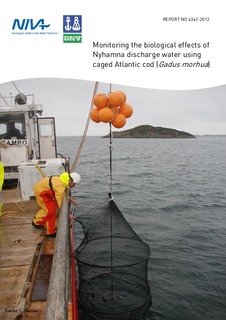| dc.contributor.author | Brooks, Steven | nb_NO |
| dc.contributor.author | Harman, Christopher | nb_NO |
| dc.contributor.author | Jonsson, Henrik | nb_NO |
| dc.contributor.author | Farmen, Eivind | nb_NO |
| dc.contributor.author | Glette, Tormod | nb_NO |
| dc.contributor.other | Brooks, S. - Project manager | nb_NO |
| dc.coverage.spatial | | nb_NO |
| dc.date.accessioned | 2014-08-01T10:57:28Z | |
| dc.date.available | 2014-08-01T10:57:28Z | |
| dc.date.issued | 2012 | nb_NO |
| dc.identifier | 6341 | nb_NO |
| dc.identifier.isbn | 978-82-577-6076-2 | nb_NO |
| dc.identifier.issn | 1894-7948 | nb_NO |
| dc.identifier.uri | http://hdl.handle.net/11250/215904 | |
| dc.description.abstract | The potential biological effects of the process water (PW) from the Nyhamna gas processing plant on the West coast of Norway was assessed using biological responses in the Atlantic cod, Gadus morhua. Farmed cod were placed in large mesh cages at strategic locations from the Nyhamna PW discharge outlet including: 1) <50 m from the outlet; 2) 300-400 m downstream from the outlet; and 3) reference location (4-5 km from the outlet). A suite of biomarkers were measured in the cod following a relatively short (10 day) and a long (9 week) exposure duration. The biomarkers measured after 10 days were micronuclei formation (MN), vitellogenin (VTG) and ethoxyresorufin-O-deethylase (EROD), whilst those measured after 9 weeks included gill and gonad histopathology, peroxisomal proliferation, and neutral lipid content of the liver. Supporting parameters including condition index (CI), liver somatic index (LSI) and plasma chemistry were measured in fish from both short and long exposures. The exposure of the fish to chemicals thought to be present within the PW following treatment was determined using bile metabolites of exposed cod, together with passive sampling devices. The passive sampling devices included polar organic chemical integrated samplers (POCIS) and diffusion gradients in thin films (DGTs), which were used to target alkylphenols (APs) and metals respectively. POCIS and DGTs were able to detect APs and metals within the receiving waters at Nyhamna but were only found to be present in low concentrations. There were no significant increases in biomarkers with proximity to the discharge outlet. Fish held within cages less than 50 m and 300-400 m from the discharge outlet had no significant effect on any of the biomarkers measured when compared to the reference and pre-exposure groups. The CI, LSI, and plasma chemistry clearly showed that fish caged for 9 weeks had suffered from starvation, which also resulted in fish mortalities in one of the fish groups. Overall, based on the chemical assessment of APs and metals in the receiving waters at Nyhamna using POCIS, DGTs and bile metabolites, the PW discharge posed little to no environmental risk. The exposed cod appeared to be unaffected by the PW discharge with no significant biomarker responses despite the close proximity (<50 m) to the discharge outlet. | nb_NO |
| dc.description.sponsorship | Norske Shell | nb_NO |
| dc.publisher | Norsk institutt for vannforskning | nb_NO |
| dc.relation.ispartofseries | NIVA-rapport;6341 | nb_NO |
| dc.rights | Navngivelse-IkkeKommersiell-DelPåSammeVilkår 3.0 Norge | nb_NO |
| dc.rights.uri | http://creativecommons.org/licenses/by-nc-sa/3.0/no/ | nb_NO |
| dc.subject | ecotoxicology and risk assessment | nb_NO |
| dc.title | Monitoring the biological effects of Nyhamna discharge water using caged Atlantic cod (Gadus morhua) | nb_NO |
| dc.type | Research report | nb_NO |
| dc.rights.holder | Norsk institutt for vannforskning/Norwegian institute for water research | nb_NO |
| dc.subject.nsi | VDP::Matematikk og naturvitenskap: 400 | nb_NO |
| dc.source.pagenumber | 51 | nb_NO |
| dc.subject.keyword | produktsvann | nb_NO |
| dc.subject.keyword | biomarkør | nb_NO |
| dc.subject.keyword | fisk i bur | nb_NO |
| dc.subject.keyword | passive prøvetakere | nb_NO |
| dc.subject.keyword | produced water | nb_NO |
| dc.subject.keyword | biomarkers | nb_NO |
| dc.subject.keyword | fish in cages | nb_NO |
| dc.subject.keyword | passive samplers | nb_NO |
| dc.relation.project | O-11196 | nb_NO |


